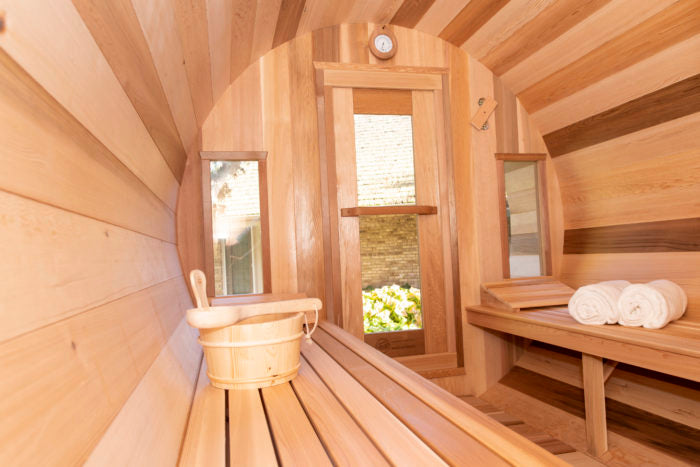More About Traditional Sauna
More About Traditional Sauna
Blog Article
Some Ideas on Traditional Sauna You Need To Know
Table of ContentsGetting My Traditional Sauna To Work3 Simple Techniques For Traditional SaunaSome Known Details About Traditional Sauna What Does Traditional Sauna Do?Excitement About Traditional Sauna
The majority of the weight shed in a sauna is water loss and is re-gained upon rehydrating. Without an uncertainty sauna can be an important part of a healthy and balanced weight loss program. To look at the differences between traditional and IR saunas, I will separate these into verifiable, theoretical, and fabricated distinctions.Hence, the best factor in the saunawhich goes to the ceiling straight over the sauna heateris commonly in between 185 and 190 F. Claims that a traditional sauna goes beyond 200 F is merely not real and not applicable for electrical saunas marketed in the United States. The temperature level for a far-infrared sauna is normally set in between 120 and 140 F; nonetheless, unlike the standard sauna, the goal in and IR room is not to achieve a heat.
Due to this, the temperature level difference is practically irrelevant, since extreme sweating causes both sauna types, but the approach of heating up the body is different. In an IR sauna the bather will certainly really feel hot and will certainly sweat a lot, but at a lot reduced temperatures. Traditional Sauna. Thus, if the objective is to spend longer durations of time in the sauna, the IR sauna is an excellent option

Rumored Buzz on Traditional Sauna

When the high temperature is accomplished, the components cycle on and off to keep the heat. Traditional Sauna. Most conventional sauna individuals take pleasure in putting water over the rocks to develop vapor to elevate sauna moisture degrees. The advantages of putting water over the rocks consist of: making the space a lot more comfortable, moistening the nasal flows, and enabling the use of aromatherapy by blending important oils with the water
In a far-infrared sauna, the warm front permeate the body to successfully heat up the body and elevate the body core temperature level. To accomplish this boosted temperature, Far-infrared emitters produce infrared energy which is close to the exact same wavelength as that which the body normally emitsoften Learn More referred to as the "Important Range" of 7 to 14 microns), so the energy is well received by the body.
When the energy enters the body, it causes the body temperature level to increase and inevitably causes sweat. In an infrared sauna it is necessary for the emitters/heaters to continue to be on virtually frequently. Given that there is no mass of rocks to preserve warm, the sauna will certainly cool if the emitters shut off.
Our Traditional Sauna Ideas
As discussed over, the sauna bather in an infrared space wants to place himself before operating emitters to obtain maximum gain from the heat. The home heating time for the two areas can be extremely different, relying on exactly how the rooms are utilized. For a standard sauna, a Home Page bather should permit 30-40 minutes for the area to accomplish a wanted temperature and to properly pre-heat the rocks.
A well created sauna will generally accomplish a temperature level of 150-160 F in about 30-40 minutes. For hotter temperature levels, the area may need to warm for a longer duration.

Standard saunas have a tendency to be bigger (for this reason utilize more electrical power) than infrared saunas, although conventional saunas are definitely readily available in one and 2 person sizes as well. For a two-person standard sauna, 5x6 or 5x7 size is most popular. The leading bench can easily seat two or three individuals and is likewise enough time to exist down throughout the sauna session.
The 2-Minute Rule for Traditional Sauna
The typical cost per kWH of power in the U.S. is about $0.11 - Traditional Sauna, so a 4.5 kW heating unit will set you back around $.50 to run for one hour, if the heating unit runs continuously for one hour. Typically a sauna heating system will compete 75% of the first hour and 50% of succeeding hours on because the aspects cycle once the established temperature is accomplished
A 2 person far-infrared room is usually literally smaller sized than a conventional sauna, usually regarding 4' x 4' or smaller. The IR heater is typically 1.5-1.7 kW utilizing a 120 volt 15 amp plug-in solution. Given that the room can be made use of faster than a sauna space, we will presume the area is used for to of an hour consisting of warm up time.
There is a hardly ever this link reviewed distinction in the social experience between the 2 spaces. While our culture has shed a few of the social advantage of the typical sauna experience, it can be very socially satisfying. From family members time in the sauna, to heart-felt discussions with significant others, to sauna partiesthe conventional sauna experience can result in intimate interacting socially.
Facts About Traditional Sauna Uncovered
The majority of higher end infrared rooms consist of colored light therapy, noise systems and full-glass fronts.
Report this page